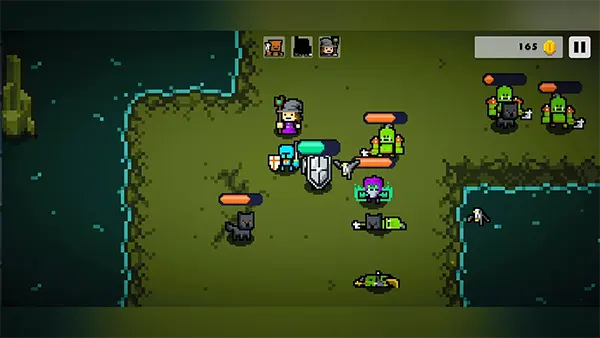MageTrain is an unusual blend of retro mechanics and modern roguelike progression. At its core, it reimagines the simplicity of the classic snake game, but instead of growing a chain of squares, you build a party of heroes. Each victory over enemies adds a new ally, turning the train into a squad with distinct abilities. In 2025, MageTrain continues to attract attention thanks to its mix of nostalgia, tactical depth, and replayability.
Core Gameplay and Mechanics
The central mechanic of MageTrain is the growth of a hero party. Unlike the endless survival challenge of the original snake, each addition brings not just length but also combat potential. Heroes automatically attack, combining abilities in ways that reward planning. The roguelike format introduces variety: no two runs are identical, and each dungeon presents new combinations of foes and rewards.
More than thirty unique skills are available, ranging from ranged attacks to defensive barriers. This system ensures that players cannot rely on a single strategy. Instead, adaptability becomes key as new heroes join and old ones fall. The synergy between abilities can transform a weak formation into a powerful force able to handle tougher stages.
The eight dungeons included at launch represent different themes and tactical demands. Some rely on swarm enemies, while others focus on elite bosses with dangerous mechanics. This design encourages experimentation, as players learn which team compositions thrive in each environment.
Progression and Character Development
Progression in MageTrain is not limited to a single run. While roguelike randomness defines immediate challenges, character development offers long-term motivation. Heroes gain improvements, and unlocking new skills creates diversity for future attempts. This blend of short-term tactical play and long-term growth aligns it with modern roguelike expectations.
Players also have choices regarding special upgrades. Some empower individual heroes, while others affect the train as a whole. For example, bonuses may boost healing, expand attack range, or strengthen defences. Each decision influences the course of a run, making strategy more meaningful.
The replayability factor is heightened by hidden interactions between skills. Discovering these synergies requires patience and experimentation, rewarding players with stronger and more efficient teams over time.
Visual Style and Atmosphere
The visual presentation of MageTrain blends retro aesthetics with a fantasy theme. The heroes and dungeons are stylised but clear, ensuring that players always understand the situation on screen. The design balances nostalgia with readability, a critical factor when managing an expanding party in real time.
Each dungeon introduces unique artwork, sound design, and enemy behaviour. For example, icy caverns emphasise survival against freezing enemies, while fiery chambers challenge players with explosive hazards. This variety ensures that runs remain fresh and engaging even after multiple attempts.
The soundtrack reinforces the game’s identity. It combines chiptune influences with modern orchestral layers, enhancing immersion without distracting from gameplay. As a result, MageTrain manages to capture both the spirit of old-school gaming and the atmosphere of a tactical fantasy adventure.
Appeal to Different Player Groups
MageTrain’s hybrid nature makes it attractive to several audiences. Long-time players of the original snake will recognise the structure, while roguelike fans will enjoy its depth and challenge. The ability to build and lose heroes throughout each run adds tension and excitement that appeals to competitive players.
Casual gamers also find accessibility here. Automatic combat means that players can focus on positioning and strategic decisions rather than complex controls. The learning curve is gentle, but the depth ensures that mastery requires effort.
For mobile gamers in 2025, MageTrain offers short yet meaningful play sessions. Its design supports both quick runs and extended sessions, fitting into varied lifestyles without losing its appeal.

Innovation and Place in Modern Gaming
By merging one of the simplest arcade formats with roguelike systems, MageTrain illustrates how old ideas can evolve into something fresh. The concept is straightforward, yet its execution highlights the creativity of modern indie design. It is not just about nostalgia; it is about transforming familiar mechanics into deeper experiences.
In the context of the 2025 gaming landscape, MageTrain stands as an example of how independent studios compete with larger projects by focusing on originality. Its balance of simplicity and complexity shows that innovation does not always require massive resources, only strong ideas.
The game also reflects a wider trend: the revival of classics through hybridisation. Much like other projects that reinterpret arcade hits, MageTrain demonstrates that blending genres can produce titles with both retro charm and contemporary relevance.
Future Potential and Community Impact
The potential of MageTrain extends beyond its initial release. Updates introducing new dungeons, heroes, and skills could expand its lifespan significantly. Roguelike communities thrive on variety, and this game has the foundation to support ongoing content additions.
Community involvement may also play a role. Sharing strategies, discovering hidden synergies, and debating the best hero combinations already form part of the game’s appeal. Forums and streaming platforms amplify this, helping the game reach broader audiences.
Ultimately, MageTrain’s strength lies in its dual appeal: a nostalgic reminder of simpler times and a robust roguelike experience. Its continued growth in 2025 and beyond will depend on how well it maintains this balance while offering new content to keep players engaged.

